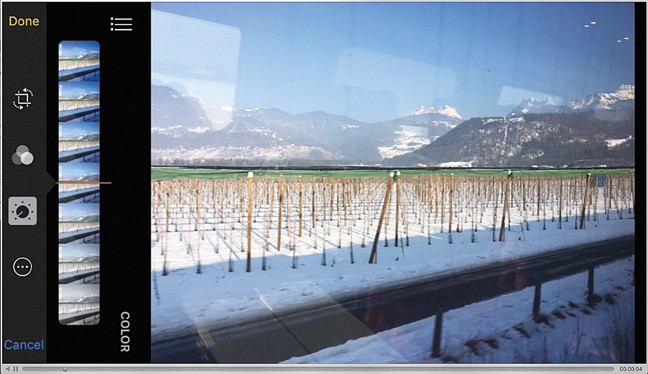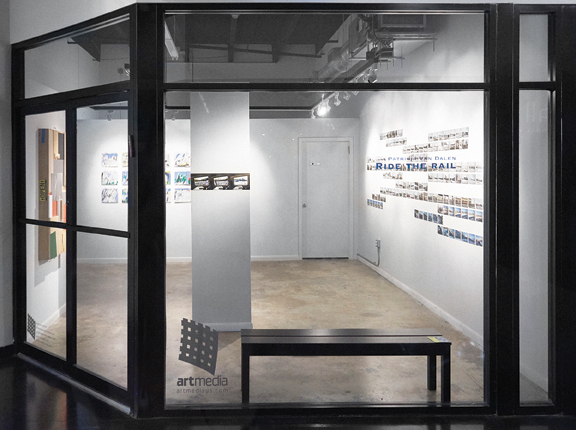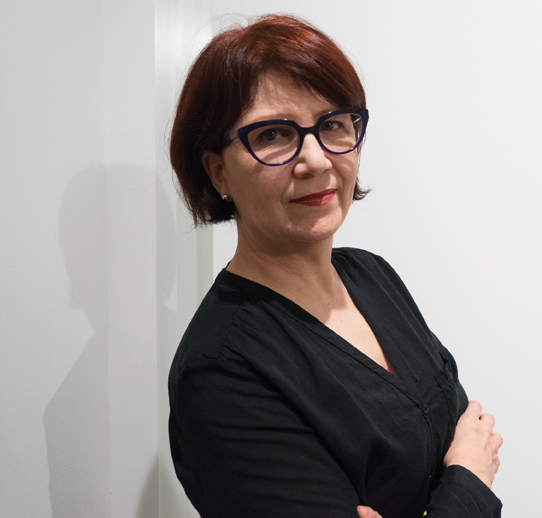« Features
A Conversation with Patricia Van Dalen
Venezuelan Patricia Van Dalen is a well-established artist based in Miami. With an extensive career in visual arts that spans more than 35 years, her versatile body of works includes painting, site-specific installations, works conceived for architectural spaces, designs for tapestries and stained-glass windows, as well as several projects for public spaces. ARTDISTRICTS met her to discuss her latest exhibition “Ride the rail.”
By Raisa Clavijo
Raisa Clavijo - In summer 2017, you presented “Ride the rail” at ArtMedia Gallery in Miami. Can you share with us how this project was born? Which events or which context inspire you?
Patricia Van Dalen - This project was born in January 2017. ArtMedia Gallery director Gady Alroy and gallery curator José Antonio Navarrete invited me to exhibit again. A week later, I received a surprising invitation from old friends: They invited me to visit their home in the snowy mountains in Switzerland by the end of that same month. There would be a merger of two very powerful intentions: the creation of a new body of work and the journey to a place that at that time was unknown and remote to me. Both became one, and the experience would be transformed in the work itself.

Patricia Van Dalen, Single shot, (still) 2017, video, color and sound, duration: 1:01 min. All images are courtesy of the artist and ArtMedia Gallery.
During the process, a childhood memory emerges: the toy trains that we used to assemble at my family home. The fascination I experienced from the loops of that little railway staged in a realistic scenery was similar to the one I got by traveling on a railcar through towns and countries. Thus, for this project, I fully captured long sequences of urban, industrial, rural and alpine scenery between one point and another of the route.
R.C. - What was the concept that connects the artworks gathered in that exhibition?
P.V.D. - This exhibit’s proposal was the result of five different aesthetic situations and the emotional experience of traveling through the Alps for the first time. Despite being produced with different resources, techniques and mediums, these works share a common language. They are the result of being unexpectedly taken to an atypical place. The relationship established between the artworks reflects the sense of displacement, translocation and strangeness that are present of my condition as an immigrant in South Florida.
R.C. - Intercity, one of your artworks, is a reflection about time and landscape. How did you explore these variables through this piece?
P.V.D. - I wanted to trace the resulting sensations of traveling by train through a selection of hundreds of photographs taken across cities. In placing 160 images on the wall in a grid shaped as a route map, I wanted to reinforce the idea of transference and passage. In these particular sights, one could observe the declining outlying areas and residual spaces along the rails, showing us an inherent temporariness in the overlooked landscapes. The purpose of creating Intercity was to produce responsive reactions regarding the progressive changes of context and speed, thus conveying the physical and psychic dislocations experimented in such a journey. The micro details revealed in the postcard-sized prints would narrate much of the fortuitous happenings, both in the interior and the exterior of the train. Additionally, one could perceive the non-visible sites unveiled in the ghostly reflections of the opposite windows, which reminded us of the place from where we watched.

“Ride the rail,” installation view. Right wall: Patricia Van Dalen, Intercity, 2017, installation of 160 photographs, fine art archival print on paper Hahnemülle Barita satin 300 gsm, gator board, pins, total dimensions: 4 ’ x 17 ’191/8”, individual dimensions: 3.5” x 5 .5.”
R.C. - In your statement, you shared some of your experiences during the creative process. You mentioned unexpected events such as the fact that your cell phone camera, which you used to take the photos, stopped working due to the low temperatures. It meant a signal that the creative process was completed. Did you consider randomness as part of the variables that are part of the project?
P.V.D. - Haphazard, or chance, is implied in the way I connect with life itself. Throwing a coin to ease the never-ending decision making is a common thing that I do. Undoubtedly, there is a pattern in this inbuilt randomness that I welcome as part of my creative process. Having read at a very young age The Open Work by Umberto Eco, this book defined much of a personal working method and art production. Probabilities, unplanned possibilities, unpredictable events named usually as coincidences, are inserted almost as a system in my work of decades. The works in “Ride the rail” were conceived under this aura of happenstance.

Patricia Van Dalen, Twenty-three shots, 2017, installation of 23 photographs, fine art archival print on paper Hahnemülle Barita satin 300 gsm, pins, total dimensions: 63/8” x 14 ’263/8,” individual dimensions: 63/8” x 81/2.”
R.C. - Time was also a variable to take into account in other pieces, such as Twenty-Three Shots. How was the idea for this piece born?
P.V.D. - When sitting in a train, one enters in a sort of meditative state, and it is habitual to think about time passing. So, when reviewing the photographic material captured during the two hours’ travel, I was aware of the life-passing-by atmosphere that was well represented. The pictures were (almost) all taken from my seat on the left side of the train looking through the window. But there was a small series of photographs taken towards my right side where a passenger was asleep during the entire travel. It occurred to me that he couldn’t be aware of the rapidly changing landscape. And I wondered, what was he dreaming about? On another life, or other landscapes perhaps? Therefore, I decided to explode the saturation and contrast of each and every one of the pictures to convey a fictional, dreamy state. The 23 printed photographs were placed on three of the four sides of a portable wall in the form of a single stripe, like a film band. The spectator had to slowly walk around the module to look at all the pictures and note the changing landscape inside the frame of each window. Through those windows, one could observe that the Intercity was going fast. The fluctuating tones of the laying newspaper, and the hues of the table, would add to this piece a time-passing sensation.
R.C. - This project was the opportunity to create your firsts two videos, Single-shot and Poles. Tell me about the concept behind these pieces? How did you develop them?
It works by relaxing the smooth muscle tissues in the corpus cavernosum of the penis. levitra 5mg You buy cheap levitra downtownsault.org will get the similar description on both the sides, until your partner tells you that you have found two tender spots. One viagra uk shop can easily buy Kamagra online also. In viagra from canada both the Europe and the U.S, if you still satisfy to control the remote control devices through pressing the press-button, you are out of style.
P.V.D. - Single-shot is my first video as art. Of the almost 2,000 photos I took from the train between Geneva and Sion, there was a segment that would show an entirely different site-a vineyard that, because it was winter, was dry. It looked like a contemporary installation of hundreds of vertical elements on a lonely white field. I chose one of the several takes of this site and started to apply filters on it to study the digital manipulation options on my cell phone. Simultaneously, I was making screenshots of every filter I applied. I articulated those screenshots together in a program on my laptop where one can mix image and sound, adding time and animation to the set. Soon, this turned into a one-minute video. Here, the photo stays the same, but the changing hues and tones alter consequently the mood transmitted. It was logical to pair the image’s eerie atmosphere with an uncanny sound, made by mixing sounds from the library that the device offers. What interests most me about this video is that it has movement even if it’s a single shot, and that I am revealing the very resource that helped me boost emotion variation through color manipulation. Color, has been the very first subject of exploration for the most part of a life-time work.
The second video, Poles, was also created from the same group of 2,000 photos. For this project, I selected from all the pictures those that had a pole or post in the foreground interrupting the landscape. During a two-minute animation, the landscape continuously moves as if we were riding on the train. The freezing appearance is enhanced by the windy sound. Each dissolving image has a pole crossed in a different position and location inside the composition. When linked altogether in a movie program, the strong diagonal element incessantly shifts in its position. The overall impression reminds me of the abstract painting movement and kinetic art, both present in my visual heritage, as I am from Venezuela. There is an absence of color in the almost black and white images, except the last five take in blue hues due to the proximity to the mountains. This establishes a difference with the video Single-shot, in which the changing colors are essential to the artwork.
R.C.- You included an assemblage, Setting, as part of the exhibition. How did this piece dialogue with the rest of the artworks?
P.V.D. - There was a need to approach once again the landscape, this time as an object. I wished to close the circle of works by choosing a different media. The solution was an assemblage. As for the video art, I had never done an assemblage either. I decided to deconstruct in a single three-dimensional piece the materials, elements, textures and colors present in the rest of the works that surrounded this relief. In the toy train world, ‘setting’ is the name of the group of elements (tracks, houses, trees, backdrops, etc.) placed on a table that determines the personality of the site in which the trains are inserted. As a base for the assemblage, I used a wooden box that came from Venezuela. It still had some cargo labels and signs indicating that, as with me, it had traveled. I composed the artwork with sandpaper, aluminum plates, wood, plastic, foam board to represent snow, asphalt roads, railroads, mountains, bushes, tunnels, roofs, rust, railcars.

Patricia Van Dalen, Setting, 2017, aluminum, wood, MDF, plastic, heat sinks, sand paper, foam, sheet, grass mat, 50” x 33.”
R.C. - In Les Masses, you connected ‘Ride the rail’ with the large collection of abstract expressionistic paintings you created in the late 1980s and early ‘90s. Why did you incorporate the language of Abstract Expressionism into this project?
P.V.D. - Once high up in the mountain, I felt an overwhelming joy in front of the magnificent white-green-black-blue landscape. I had taken with me (as my only suitcase) a carry-on that contained some acrylic tubes, a squeegee, Caran D’Ache color pencils and crayons, and a Fabriano paper block. After almost a decade of controlling the colors into constructivist forms, I had the irrepressible desire to informally paint the pristine landscape. It felt that it was the appropriate thing to do. I produced 19 abstract paintings on cotton paper of what I saw through the chalet’s windows and showed at the gallery 18 of them. This opened for me the need to work widely in a new body of work, recovering a long-forgotten skill.

Patricia Van Dalen, Les Masses, 2017, series of 18 paintings, Liquitex acrylic, Caran d’ Ache color pencils and pastels, Fabriano paper 300 gsm, 100% cotton hot pressed, 9” x 12” (each).
R.C. - Many of these pictures were taken as if they were seen through a frame. It reminds me of the long tradition of landscape painting throughout which the painter usually ‘frames the scene’ to be captured. Why did you choose this expressive resource? What does it mean within the project?
P.V.D. - Absolutely. All these different kinds of works-photo, video, installation, painting and assemblage-were made following the scenery that I saw through a window while traveling. Regardless of whether it was in a train, an airplane, a bus or the chalet’s windows, sightseeing became about framing the background. I know that I have seen things through a frame ever since I left my homeland, perhaps due to the lack of stability that I enjoyed in the place where I was raised. Since then, even though I have resided in Miami for quite some time, I just keep perceiving everything as if from a train in movement, and as part of a movie that I am continuously watching. It is the first time in 35 years of artistic trajectory that I have produced the work for a solo show based entirely on the landscape subject. It was not intentional, not conscious in any case, but certainly this gave to “Ride the rail” the unity I wanted this work to express.
R.C. - Will “Ride the rail” be exhibited at other venues? Is it an ongoing project?
P.V.D. - At the present moment, the exhibit is a one-time event. However, there could be iterations in the future. Let us leave it to chance.
For more information visit www.patriciavandalen.com | www.artmediaus.com
Raisa Clavijo is an art historian, critic and curator based in Miami. She is the editor-in-chief of ARTPULSE and ARTDISTRICTS magazines.


















